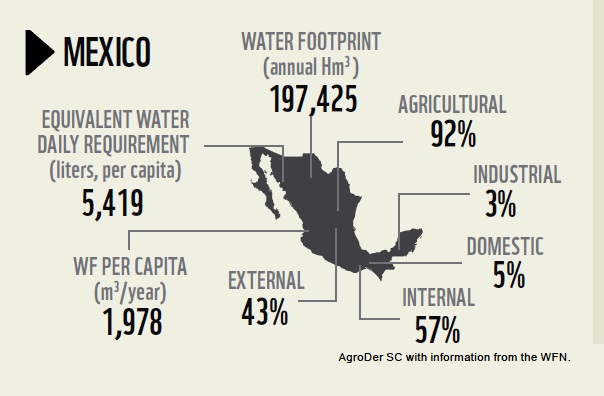In a previous post, we saw how Mexico is a major net importer of “virtual” water. In this post we take a closer look at Mexico’s water footprint. The data throughout this post come from The Water footprint of Mexico in the context of North America (pdf file).
Individual products each have their own water footprint in terms of the total amount of water involved in their production, processing and marketing. For example a single cup of coffee represents (on average) a water footprint of 140 liters. Other water footprints include:
- A single letter-sized sheet of paper – 10 liters
- Microchip – 32 liters
- Pair of leather shoes – 8000 liters
- Glass of milk 200 liters
- Glass of wine 120 liters
- Tomato 13 liters
- Hamburger (150 gram) 2400 liters
From numbers like these, it is possible to calculate the water footprint for an individual consumer in a particular country, and also for an average consumer in each country.
How does the water footprint in Mexico compare to other countries?
The graphic shows that Mexico’s total water footprint (all consumers) is 197,425 Hm³, of which 92% is agricultural, 3% industrial and 5% domestic. Only 57% of Mexico’s water footprint is internal, the remaining 43% is external (ie water used in other countries to make or produce items imported into Mexico). The average water footprint per person in Mexico comes to 5419 liters/day (or 1978 m³/year).
The global average water footprint (all countries, all consumers) in 2010 was 1,385 m³/y. However, some countries have much higher average water footprint/persons than others. For example, the average consumer in the USA has a water footprint of 2,842 m³/y, whereas in China and India the average water footprints are 1,071 and 1,089 m³/y respectively.
The water footprint of an average consumer worldwide is primarily determined by their consumption of cereal products (contributes 27% to the average water footprint), followed by meat (22%) and milk products (7%).
It should be remembered that countries which heavily rely on foreign water resources may have significant impacts on water consumption and pollution elsewhere.
Full report:
Related posts:

Sorry, the comment form is closed at this time.